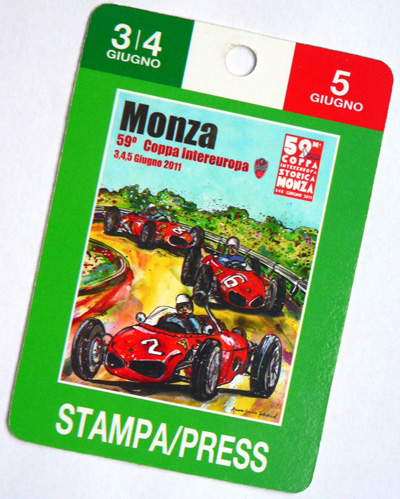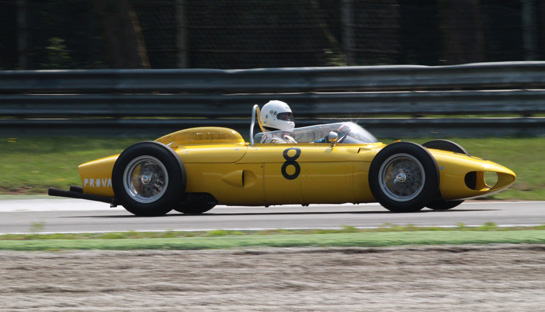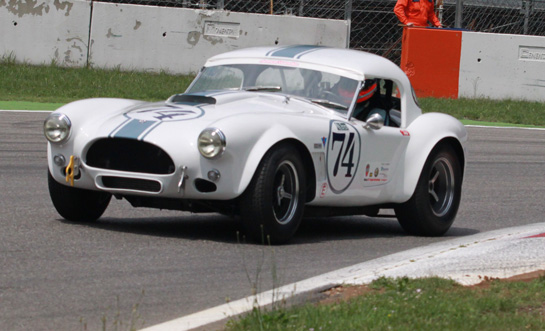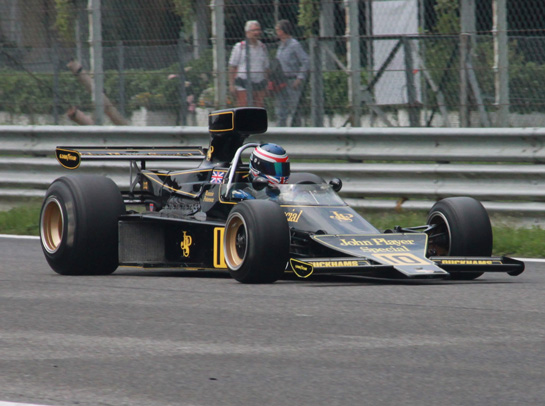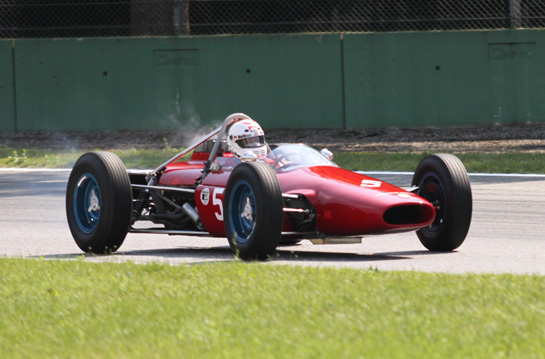COPPA INTEREUROPA STORICA
Over 350 cars entered in more than 16 races, 1500 show cars and the presence of about 20 thousand spectators marked the success of the 2011Coppa Intereuropa, eagerly awaited by lovers of classic cars. Below, Roberto Motta describes this year’s event in both English and Italian (Italian text below photos)
Last weekend, the legendary Monza circuit hosted the 59th Coppa Intereuropa. For three full days drivers from around the world danced between the curbs of the historic Monza circuit. The Coppa Intereuropa is the most important race series for historic cars held in Italy, and one of the most important worldwide.
Originally established in 1949 as a three hour race car for Touring and fast Touring, the Intereuropa Cup was a great success, and merged with the F1 race at Monza. But after a few years, the Intereuropa ceased to exist. In 2008, the Coppa Intereuropa was revived by the current organizers (one of the prime organizers was Marco Cajani, the President of Scuderia del Portello) as an event for classic cars.
This year at Monza were some of the finest classic cars in the of categories of single seaters F1 and F2, GT, (See Sedans and GTs at Intereuropa) Sports Prototype of the 1960s and 1970s, and the thundering cars that participated in the Canadian-American Challenge Cup (Can Am).
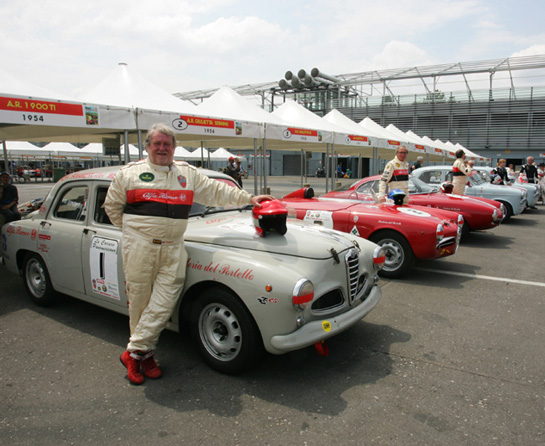
Marco Cajani stands before a line up of Scuderia Portello team cars. Cajani is one of the organizers of the very successful Intereuropa revival. Credit Scuderia Portello
Among the most spectacular races is the ‘Trofeo tutto Alfa’, organized by Scuderia del Portello. This trophy event represents an important part of the history of the famed Milan brand, and this year featured over 50 Alfas built between 1955 and 1971.
Just as interesting are the F1 races; most from a day when they raced the legendary torpedo-shaped car with no frills, ailerons, or gimmicks, but the grids also included ground effect cars from the 70s and 80s. For the record, the F1 race was won by Patrick D’aubreby with a 1985 Tyrrell in 1985, and in second place was Richard Eyre, driving a Williams FW08 from 1982, followed by Richard Barber, driving a 1978 Fittipaldi.
Despite the presence of only six cars, the Can Am race was filled with giants like the McLaren M8F, the March 707, the Lola T310 and the beautiful Shadow AVS MkI 1970. Made by Advanced Vehicle Systems’ Don Nichols, this car was not successful in the race, but still wins with the originality of his technical design. (See Formula and Sports Racers)
As a special feature of the event was a tribute to two late champions, Phil Hill and Elio De Angelis. Hill passed away on August 28th 2008, and De Angelis was killed in May 15th 1986, during a series of tests at Paul Ricard in Le Castellet while driving a de Brabaham BT55. For the occasion, a race was organized with F1 cars of the time with cars from Hill’s era and a parade of cars, with two of the Lotus’s originally driven by Elio De Angelis, taken around the track by Beppe Gabbiani and Emanuele Pirro. The Phil Hill Trophy Race was won by the Lola Mk4 of Mark Piercy and the award was given by Phil’s widow Alma, and son Derek Hill. Derek also was entered in the GT event driving a Shelby Cobra.
Among the most admired cars that participated in the Phil Hill Trophy, was the faithful replica of the Ferrari 156 “Sharknose” in which Phil Hill won the F1 world championship in 1961. The car, owned by Dutch collector Jan Biekens was rebuilt with the original engine and chassis taken from the original drawings from Maranello. It was the first time Derek Hill had ever seen a car similar to his father drove to the World Championship.
A very interesting Lotus appeared at the Coppa Intereuropa this year. At the time of its presentation, the Lotus 76 had some interesting innovations, such as an aerodynamic rear wing of a biplane type, and the electronically operated clutch that could be operated with a button on the gearshift. Unfortunately, 76 was a disappointment and after four races, the car was abandoned and the team continued the season with a hybrid car that took advantage of the features of both the Lotus 72 and the 76.
Among the sports car highlights was the debut of the legendary Alfa Romeo 33-T3-001, 1971, brought by the President of the Scuderia del Portello, Marco Cajani. “To debut at the Monza circuit, the car made some laps on the track of Adria, where we made sure everything worked,” Cajani told us. “The restoration of the car was completed recently, so there is some fine tuning and testing to be done.” The 33-001 is of great historical value, having made its race debut in tests of the Targa Florio in 1971.
Like a true diva, following the whims of youth, the Alfa did not allow Cajani to drive during the free practice on Friday, but the 33-T3-001did participate in the 1000 km Challenge. (see Coppa: All Alfas).
Among the best-known drivers who attended the event, Arturo Merzario remembers that, as always, he tries to compete in several categories at each event. Merzario, born in Civenna (Como) in 1943, is certainly not a ‘rookie’ in the Intereuropa Cup, a race in which he debuted in 1963 driving an Alfa Romeo Giulietta SZ. He made his racing debut with a Giulietta spider on the Monza track in 1962, ending the race in eighth position. After a long career, driving for Alfa, Abarth, Ferrari, Merzario still has a go at many vintage events. As in the past, he likes to enter as many races during the weekend as possible, and this year’s Intereuropa saw him in four different cars and races.
For full results and entry lists, go to:
http://www.monzanet.it/it/
COPPA INTEREUROPA STORICA;
I MITI DEL PASSATO TORNANO IN PISTA A MONZA
Testo e foto di Roberto Motta
350 vetture impegnante nel corso di 16 gare, 1500 vetture stradali e la presenza di migliaia di spettatori, segnano il successo dell’evento più atteso dagli amanti delle vetture storiche
Lo scorso weekend, il mitico tracciato di Monza ha ospitato la 59a Coppa Intereuropa, un appuntamento imperdibile per gli appassionati di auto storiche, che ha visto in gara piloti provenienti da tutto il mondo.
In una tre giorni vissuta senza un attimo di respiro, hanno danzato tra i cordoli dello storico circuito brianzolo alcune delle più belle vetture storiche di ogni categoria, dalle monoposto della categoria F1 e F2, alle GT, alle Sport Prototipo degli anni ’60 e ’70, alle mastodontiche vetture che parteciparono alla Canadian-American Challenge Cup (Can Am).
La Coppa Intereuropa è la gara di auto storiche più importante tra quelle che si disputano in Italia, e una tra le più importanti a livello mondiale.
Nata nel 1949, come gara di tre ore riservata alle auto Turismo e Turismo veloce, la Coppa Intereuropa ebbe un grande successo tanto da divenire la manifestazione di contorno del GP di F1, per essere poi ripresa come manifestazione dedicata alle auto storiche. Nel 2008, dopo un paio d’anni di assenza, la Coppa Intereuropa stata riportata in auge dagli attuali organizzatori, tra cui dall’architetto Marco Cajani, presidente della Scuderia del Portello.
Il programma in pista ha visto la presenza di 350 vetture in gara, impegnante nel corso di 16 gare e la presenza di circa 20mila spettatori.
Tra le gare più spettacolari il ‘Trofeo Tutto Alfa’, organizzato direttamente dalla Scuderia del Portello. Un trofeo che è stato in grado di rappresentare una parte importante della storia del blasonato marchio milanese, con la presenza in gara di oltre 50 vetture costruite tra il 1955 e il 1971.
Interessanti anche le gare riservate alle F1 storiche, dove hanno gareggiato le mitiche monoposto a forma di siluro, e prive fronzoli e alettoni, oltre alle più recenti vetture degli anni ’70 e ‘80.
Per la cronaca, la gara delle F1 storiche è stata vinta da Patrik D’aubreby con la Tyrrell del 1985, mentre al secondo posto è giunto Richard Eyre, al volante di una Williams FW08 del 1982, seguito da Richard Barber, alla guida di una Fittipaldi del 1978.
La gara delle mastodontiche Can Am, pur con la presenza di sole sei vetture, ha visto la presenza di vetture interessanti come, la McLaren M8F, la March 707, la Lola T310 e la splendida Shadow AVS MkI del 1970. Realizzata dalla Advanced Vehicle Systems di Don Nichols, questa vettura non ebbe successo in gara ma, ancora oggi, colpisce l’originalità delle sue scelte tecniche.
Tra le monoposto, non sono mancate le velocissime F2, auto da sogno che hanno affascinato il pubblico grazie a gare combattute.
Nel corso della manifestazione, sono stati ricordati due grandi campioni scomparsi, Phil Hill e Elio De Angelis.
Phil Hill ed Elio De Angelis. Hill è scomparso il 28 agosto 2008, e De Angelis è rimasto ucciso il 15 maggio1986, durante una serie di test al Paul Ricard a Le Castellet, mentre era alla guida di una de Brabaham BT55. Per l’occasione, è stata organizzata una gara con monoposto F1 dell’epoca, per ricordare Hill, e una parata di vetture, in cui due delle Lotus guidate da Elio De Angelis, sono state portate in pista da Beppe Gabbiani ed Emanuele Pirro.
Il ‘Phil Hill Race Trophy’ è stato vinto dalla Lola Mk4 di Marco Piercy e il premio è stato consegnato da Alma e Derek Hill, rispettivamente la vedova e il figlio del compianto di Phil. Derek ha anche condotto in gara una Shelby Cobra nella categoria GT.
Tra le macchine più ammirate che hanno partecipato al Phil Hill Trophy, segnaliamo la replica fedele della Ferrari 156 “sharknose” con cui Phill Hill vinse il mondiale di F1 nel 1961. L’auto, di proprietà del collezionista olandese Jan Biekens è stata ricostruita con motore originale e telaio ripreso dai disegni originali provenienti da Maranello.
In questa occasione, Derek Hill ha visto per la prima volta una macchina simile a quella con cui suo padre vinse il Campionato del Mondo.
Presente in pista anche la Lotus 76-1 del 1974. Al momento della sua presentazione, la 76 presentava delle novità interessanti, come una aerodinamica che sfruttava un alettone posteriore del tipo biplano, e la frizione elettronica che poteva essere gestita con un pulsante posto sulla leva del cambio. Purtroppo, la 76 si rilevò una delusione e entrambe le novità vennero rimosse dopo le prime prove. Dopo quattro gare, la vettura venne abbandonata e la squadra continuò il campionato con una vettura ibrida che sfruttava particolari della 72 e della 76.
Tra le vetture sport segnaliamo il debutto della mitica Alfa Romeo 33-T3-001 del 1971, portata in gara dal Presidente della Scuderia del Portello, Marco Cajani.
‘’Prima di debuttare sul circuito di Monza, la vettura ha compiuto alcuni giri sulla pista di Adria, dove abbiamo verificato che tutto funzionasse ” ci ha detto Cajani “Il restauro della vettura, è stato completato da poco, e ora proseguiremo il rodaggio con attenzione, senza sottoporla ad inutili sforzi”. La 33-001, è un esemplare di indubbio valore storico, che fece il suo debutto in gara in occasione delle prove della Targa Florio del ’71.
Come una vera diva, dopo i capricci di gioventù, che non gli hanno permesso di prendere il via nel corso delle prove libere del Venerdì, la 33-T3-001ha partecipato alla 1000 km Challange ammagliando gli appassionati della Casa del Biscione.
Tra piloti più noti che hanno partecipato all’evento, ricordiamo Arturo Merzario che, come sempre, non ha avuto difficoltà a gareggiare in diverse categorie.
Merzario, nato a Civenna (Como) nel 1943, non è certo un ‘rookie’ della Coppa Intereuropa, gara in cui ha debuttato nel ‘63 alla guida di una Alfa Romeo Giulietta SZ.
Arturo ha debuttato in gara con una Giulietta Spider sulla pista di Monza nel 1962, terminando la gara in ottava posizione. Dopo una lunga carriera, alla guida di Alfa Romeo, Abarth, Ferrari, Merzario partecipa a molti eventi riservati alle auto storiche. Come in passato, quando è possibile, partecipa a più gare nel corso del weekend, e la Coppa Intereuropa di quest’anno lo ha visto gareggiare in quattro categorie verse.
